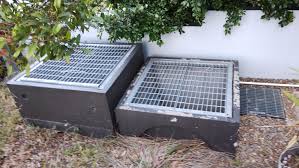
storm
Stormwater management is a crucial aspect of maintaining a safe and functional property. As a homeowner, understanding how to effectively manage stormwater can prevent issues such as flooding, erosion, and water pollution. One of the key components of a stormwater management system is the stormwater pit.
This guide will explore the different types of stormwater pits available to homeowners and factors to consider when choosing the right one You will also learn the installation process, and some maintenance tips to ensure optimal performance.
Understanding Stormwater Management
When it rains, water doesn’t just disappear. It runs off surfaces like roofs, driveways, and roads, gathering pollutants like oil, dirt, and chemicals along the way. If left unmanaged, this runoff can flood streets, erode soil, and contaminate waterways, harming plants, animals, and even people.
That’s where stormwater pits come in. These simple structures capture runoff, giving it time to settle and filter out pollutants before releasing them back into the ground or local water systems. By installing a stormwater pit on your property, you can play a crucial role in preventing flooding and protecting the environment.
Types of Stormwater Pits
When it comes to managing stormwater effectively, homeowners have several options to choose from. Each type of stormwater pit offers unique advantages and considerations:
Traditional Catch Basins
Traditional catch basins serve as basic collection points for stormwater runoff. Buried underground, they feature grates or openings to capture water flowing from surfaces such as roofs, driveways, and sidewalks.
These basins function essentially like large buckets, efficiently storing water during rain events. However, it’s essential to note that traditional catch basins typically lack advanced filtering mechanisms, primarily serving the purpose of water storage rather than comprehensive filtration.
Infiltration Pits
Infiltration pits offer a sustainable approach to stormwater management by facilitating the natural seepage of water into the ground. Unlike catch basins, which primarily store water, infiltration pits allow stormwater to recharge groundwater supplies and reduce surface runoff.
These pits are typically constructed using permeable materials and are designed to facilitate water infiltration into the underlying soil. They are particularly well-suited for properties with good drainage characteristics and permeable soils, where they can help alleviate flooding and minimize erosion.
Bioretention Basins
Bioretention basins function as natural filtration systems for stormwater runoff, resembling mini wetlands. These pits are filled with soil, plants, and gravel, which work together to naturally filter pollutants from runoff before they enter the drainage system.
These basins detain stormwater temporarily, allowing it to slowly infiltrate into the soil while being filtered and purified by the vegetation and underlying media. They offer an eco-friendly solution for homeowners seeking to improve water quality and minimize the environmental impact of stormwater runoff.
Factors to Consider When Choosing a Stormwater Pit
Now that you understand the different types of stormwater pits, learn how to choose the right one for your home:
Property Size and Layout
Consider the size and layout of your property when selecting a stormwater pit. If you have a small yard, you may need to opt for a smaller pit or explore alternative solutions like rain barrels or permeable pavement.
Local Regulations and Permits
Before installing a stormwater pit, be sure to check local regulations and obtain any necessary permits. Your city or municipality may have specific requirements regarding pit size, location, and construction materials.
Soil Type and Drainage Characteristics
The type of soil on your property can also influence your choice of stormwater pit. For example, if you have clay soil that drains poorly, you may need to install a larger pit or consider other drainage options.
Installation Process
Once you’ve chosen the right stormwater pit for your home, it’s time to install it. Here’s what you need to do:
Site Assessment and Preparation
Walk around your property and identify the best location for your stormwater pit. Make sure it’s away from buildings and utilities, and clear any obstacles from the area.
Choosing the Right Size and Type
Based on your property’s size, soil type, and local regulations, select the appropriate size and type of stormwater pit. Remember, bigger isn’t always better – you want a pit that can handle your runoff without overflowing.
Professional vs. DIY Installation
While some homeowners may feel comfortable installing a stormwater pit themselves, others may prefer to hire a professional. Consider your skills, resources, and budget before deciding which option is right for you.
Maintenance and Upkeep
Once your stormwater pit is installed, it’s essential to keep it well-maintained. Here are some tips for keeping your pit in top condition:
Regular Inspections
Regular inspections are vital for detecting any issues early on before they escalate into more significant problems. Schedule periodic inspections of your stormwater pit to check for signs of damage, such as cracks or deterioration, which could compromise its effectiveness. Additionally, look for any obstructions, such as debris or vegetation, that might obstruct water flow into the pit.
Cleaning and Debris Removal
Regular cleaning and debris removal are essential for preventing clogs and maintaining the efficiency of your stormwater pit. Leaves, twigs, sediment, and other debris can accumulate over time, hindering water flow and potentially causing overflow or flooding during heavy rain events.
Sediment and Pollutant Management
Managing sediment and pollutants within your stormwater pit is essential for maintaining water quality and preventing contamination of downstream water bodies. Sediment traps or settling basins can help capture sediment before it enters the stormwater system, reducing the risk of clogs and improving overall performance.
Get the Right Stormwater Pit Now
By choosing the right stormwater pit for your home and keeping it well-maintained, you can help prevent flooding, protect the environment, and keep your property safe and dry. With a little effort and attention, you can make a big difference in your community’s stormwater management efforts.
Write and Win: Participate in Creative writing Contest & International Essay Contest and win fabulous prizes.


